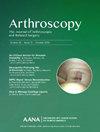Both Hamstring and Quadriceps Tendon Autografts Offer Similar Functional Outcomes After Arthroscopic Anterior Cruciate Ligament Reconstruction in Patients Aged 50 Years or Older
IF 4.4
1区 医学
Q1 ORTHOPEDICS
Arthroscopy-The Journal of Arthroscopic and Related Surgery
Pub Date : 2025-05-01
DOI:10.1016/j.arthro.2024.06.044
引用次数: 0
Abstract
Purpose
To compare the outcomes of hamstring tendon (HT) and quadriceps tendon (QT) autografts for anterior cruciate ligament (ACL) reconstruction in patients aged 50 years or older in terms of patient-reported functional outcomes, graft failure rates, complications, return to sports activity, and sports preference.
Methods
Between 2010 and 2022, prospectively collected data were obtained from an institutional database. Patients aged 50 years or older who underwent primary arthroscopic ACL reconstruction with either HT or QT autograft and had a minimum 2-year follow-up were included. Patients with concomitant meniscal, cartilage, and medial collateral ligament injuries were also included. Patients undergoing revision ACL reconstruction, those undergoing primary ACL reconstruction with a graft other than HT or QT autograft, and those with contralateral knee injuries or ipsilateral osteoarthritis (Ahlbäck stage ≥2) were excluded. Patients were evaluated in terms of the Lysholm knee score, Tegner activity level, and visual analog scale (VAS) score for pain before injury and at 2-year follow-up, as well as graft failure, QT rupture, and return to sport. The Mann-Whitney test was used to analyze unpaired samples, whereas the Friedman test was used to analyze variables over time. The χ2 statistic test was used to determine differences in categorical data between groups.
Results
The number of patients in the QT and HT groups was 85 and 143, respectively. In the QT and HT groups, the mean age was 54.4 years (range, 50-65 years) and 56.4 years (range, 50-65 years), respectively, and 49% and 51% of patients were men, respectively. The 2 groups did not differ significantly in terms of age, sex, time from injury to surgery, and concomitant injuries. No significant differences in preinjury patient-reported outcome measures, consisting of the Lysholm score, Tegner activity level, and VAS pain score, were found between the 2 groups (P > .05). At the 2-year follow-up, the Lysholm knee score, Tegner activity level, and VAS pain score improved to preinjury levels and no significant differences in preinjury and 2-year follow-up functional scores were noted between the 2 groups (P > .05). Furthermore, at the 2-year follow-up, the Lysholm score and VAS pain score did not show significant differences (P = .390 and P = .131, respectively) between the QT and HT groups. Similarly, no differences in Tegner activity level were observed between the HT and QT groups at the 2-year follow-up. No significant differences in terms of the minimal clinically important difference were detected between the 2 groups for the Lysholm knee score (P = .410) and Tegner activity level (P = .420). The 2 groups did not differ in terms of patients’ percentage of sports participation at baseline and at the 2-year follow-up (P > .05). A significant decrease (P = .01) in participation in skiing/snowboarding was reported in the HT group at the 2-year follow-up compared with baseline (116 patients [81%] vs 98 patients [69%]). No case of graft failure or QT rupture was reported in either group.
Conclusions
Arthroscopic ACL reconstruction using HT or QT autografts in athletically active patients aged 50 years or older provides satisfactory patient-reported functional outcomes and allows recovery of the preinjury level of activity.
Level of Evidence
Level III, retrospective cohort study.
对 50 岁以上的患者进行关节镜前交叉韧带重建术后,腘绳肌腱和股四头肌腱自体移植物都能提供相似的功能效果。
目的:本研究的目的是比较腘绳肌腱(HT)和股四头肌腱(QT)自体移植物用于50岁以上患者前交叉韧带(ACL)重建的疗效,包括患者报告的功能疗效、移植物失败率、并发症、运动恢复情况和运动偏好:方法:2010 年至 2022 年期间,我们从一个机构数据库中收集了前瞻性数据。纳入的患者年龄在50岁以上,使用HT或QT自体移植物进行初次关节镜前交叉韧带重建,随访至少2年。此外,还包括合并半月板、软骨和 MCL 损伤的患者。接受前交叉韧带翻修重建术或使用 HT 或 QT 自体移植物以外的移植物接受前交叉韧带初次重建术的患者,以及对侧膝关节损伤或同侧骨关节炎(Ahlback 2 期或更高)的患者不包括在内。对患者进行了受伤前和两年随访Lysholm膝关节评分、Tegner活动水平、疼痛视觉模拟量表(VAS)、移植失败、股四头肌肌腱断裂和恢复运动等方面的评估。Mann-Whitney 检验用于分析非配对样本,而 Friedman 检验则用于分析随时间变化的变量。结果:QT 组和 HT 组患者人数分别为 85 人和 143 人。QT 组和 HT 组的平均年龄分别为 54.4 [50-65] 岁和 56.4 [50-65] 岁,QT 组和 HT 组的男性比例分别为 49% 和 51%。两组在年龄、性别、从受伤到手术的时间以及并发症方面没有明显差异。两组患者在受伤前的患者报告结果评分(PROMs),如Lysholm、Tegner活动水平和VAS疼痛评分,均无明显差异(P>0.05)。在 2 年的随访中,两组患者的膝关节 Lysholm 评分、Tegner 活动水平和疼痛 VAS 均改善至受伤前水平,两组患者受伤前和 2 年随访的功能评分无显著差异(P>0.05)。此外,在 2 年的随访中,QT 组和 HT 组的 Lysholm 评分和 VAS 均无明显差异。(P=0.390;P=0.131)。同样,在 2 年的随访中,HT 组和 QT 组的 Tegner 活动水平评分也无差异。就最小临床意义差异(MCID)而言,两组之间的 Lysholm 和 Tegner 活动评分没有发现明显差异(Lysholm 评分和 Tegner 活动水平评分分别为 p=0.410 和 p=0.420)。两组患者在基线和两年随访期间参加体育运动的比例没有差异(p>0.05)。与基线相比,HT 组患者在两年随访中参与滑雪/滑雪板运动的比例明显下降(p=0.01)[116 (81%) vs 98 (69%)]。两组均无移植物失败和股四头肌腱断裂的病例报告:结论:在关节镜下使用 HT 或 QT 自体移植物重建前交叉韧带,对 50 岁以上运动活跃的患者来说,患者报告的功能结果令人满意,并能恢复到受伤前的活动水平。
本文章由计算机程序翻译,如有差异,请以英文原文为准。
求助全文
约1分钟内获得全文
求助全文
来源期刊
CiteScore
9.30
自引率
17.00%
发文量
555
审稿时长
58 days
期刊介绍:
Nowhere is minimally invasive surgery explained better than in Arthroscopy, the leading peer-reviewed journal in the field. Every issue enables you to put into perspective the usefulness of the various emerging arthroscopic techniques. The advantages and disadvantages of these methods -- along with their applications in various situations -- are discussed in relation to their efficiency, efficacy and cost benefit. As a special incentive, paid subscribers also receive access to the journal expanded website.

 求助内容:
求助内容: 应助结果提醒方式:
应助结果提醒方式:


